图 7.1 import matplotlib as mpl import matplotlib.pyplot as plt import numpy as np mpl.rcParams["font.sans-serif"]=["SimHei"] mpl.rcParams["axes.unicode_minus"]=False fig, ax1 = plt.subplots() t=np.arange(0.05, 10.0, 0.01) s1=np.exp(t) ax1
图 7.1
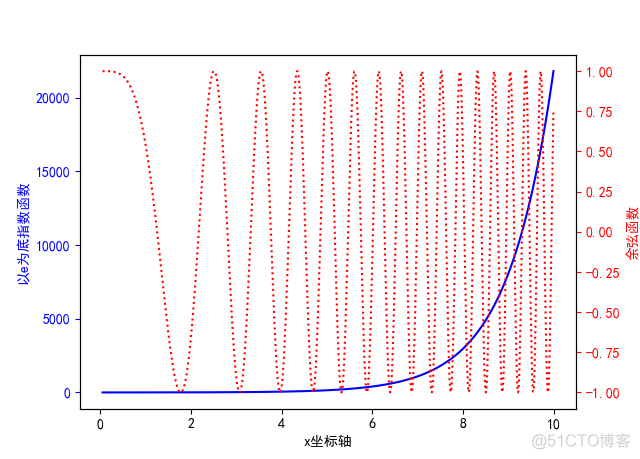


import matplotlib.pyplot as plt
import numpy as np
mpl.rcParams["font.sans-serif"]=["SimHei"]
mpl.rcParams["axes.unicode_minus"]=False
fig, ax1 = plt.subplots()
t=np.arange(0.05, 10.0, 0.01)
s1=np.exp(t)
ax1.plot(t, s1, c="b", ls="-")
ax1.set_xlabel("x坐标轴")
ax1.set_ylabel("以e为底指数函数", color="b")
ax1.tick_params("y", colors="b")
ax2=ax1.twinx()
s2=np.cos(t**2)
ax2.plot(t, s2, c="r", ls=":")
ax2.set_ylabel("余弦函数", color="r")
ax2.tick_params("y", colors="r")
plt.show()
View Code
=====================================================
图 7.2
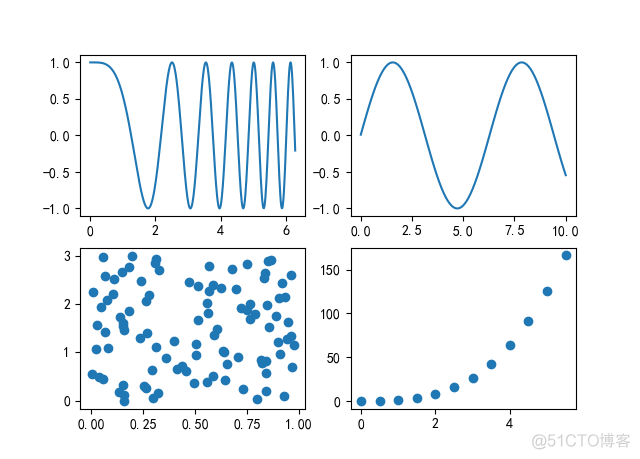


import numpy as np
x1=np.linspace(0, 2*np.pi, 400)
y1=np.cos(x1**2)
x2=np.linspace(0.01, 10, 100)
y2=np.sin(x2)
x3=np.random.rand(100)
y3=np.linspace(0, 3, 100)
x4=np.arange(0, 6, 0.5)
y4=np.power(x4, 3)
fig, ax=plt.subplots(2, 2)
ax1=ax[0, 0]
ax1.plot(x1, y1)
ax2=ax[0, 1]
ax2.plot(x2, y2)
ax3=ax[1, 0]
ax3.scatter(x3, y3)
ax4=ax[1, 1]
ax4.scatter(x4, y4)
plt.show()
View Code
=====================================================
图 7.3
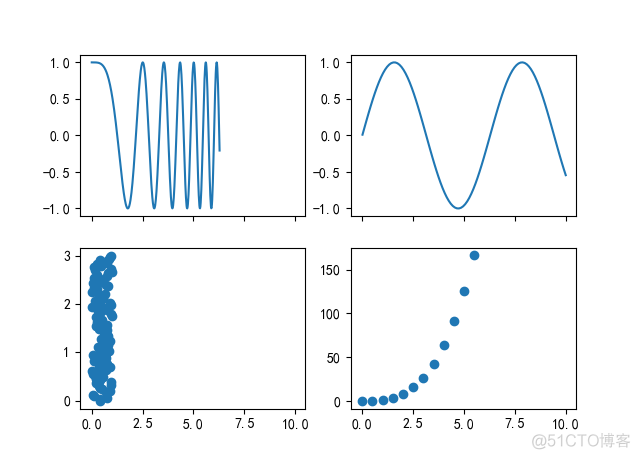


import numpy as np
x1=np.linspace(0, 2*np.pi, 400)
y1=np.cos(x1**2)
x2=np.linspace(0.01, 10, 100)
y2=np.sin(x2)
x3=np.random.rand(100)
y3=np.linspace(0, 3, 100)
x4=np.arange(0, 6, 0.5)
y4=np.power(x4, 3)
fig, ax=plt.subplots(2, 2, sharex="all")
ax1=ax[0, 0]
ax1.plot(x1, y1)
ax2=ax[0, 1]
ax2.plot(x2, y2)
ax3=ax[1, 0]
ax3.scatter(x3, y3)
ax4=ax[1, 1]
ax4.scatter(x4, y4)
plt.show()
View Code
=====================================================
图 7.4
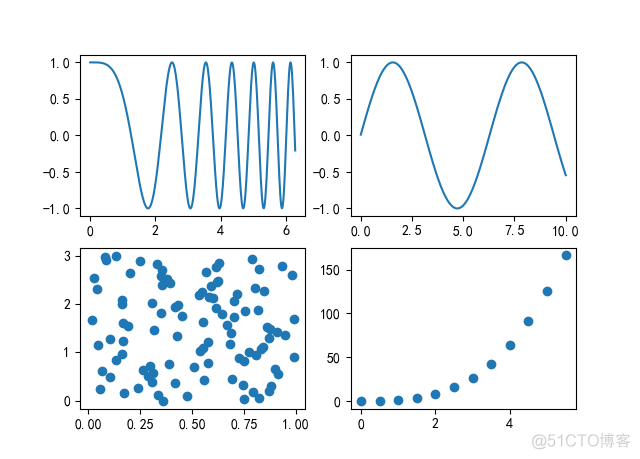


import numpy as np
x1=np.linspace(0, 2*np.pi, 400)
y1=np.cos(x1**2)
x2=np.linspace(0.01, 10, 100)
y2=np.sin(x2)
x3=np.random.rand(100)
y3=np.linspace(0, 3, 100)
x4=np.arange(0, 6, 0.5)
y4=np.power(x4, 3)
fig, ax=plt.subplots(2, 2, sharex="none")
ax1=ax[0, 0]
ax1.plot(x1, y1)
ax2=ax[0, 1]
ax2.plot(x2, y2)
ax3=ax[1, 0]
ax3.scatter(x3, y3)
ax4=ax[1, 1]
ax4.scatter(x4, y4)
plt.show()
View Code
=====================================================
图 7.5
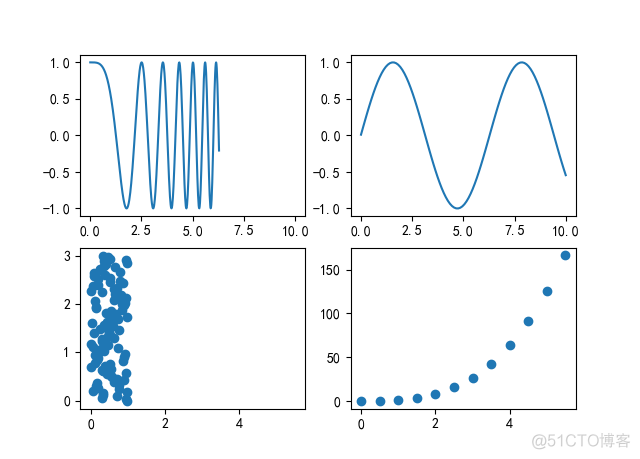


import numpy as np
x1=np.linspace(0, 2*np.pi, 400)
y1=np.cos(x1**2)
x2=np.linspace(0.01, 10, 100)
y2=np.sin(x2)
x3=np.random.rand(100)
y3=np.linspace(0, 3, 100)
x4=np.arange(0, 6, 0.5)
y4=np.power(x4, 3)
fig, ax=plt.subplots(2, 2, sharex="row")
ax1=ax[0, 0]
ax1.plot(x1, y1)
ax2=ax[0, 1]
ax2.plot(x2, y2)
ax3=ax[1, 0]
ax3.scatter(x3, y3)
ax4=ax[1, 1]
ax4.scatter(x4, y4)
plt.show()
View Code
=====================================================
图 7.6
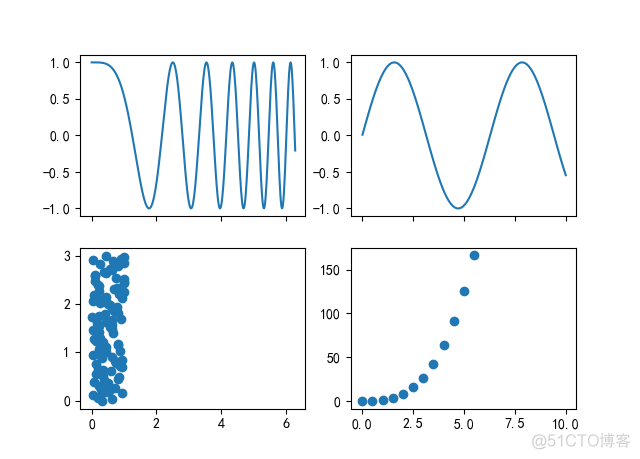


import numpy as np
x1=np.linspace(0, 2*np.pi, 400)
y1=np.cos(x1**2)
x2=np.linspace(0.01, 10, 100)
y2=np.sin(x2)
x3=np.random.rand(100)
y3=np.linspace(0, 3, 100)
x4=np.arange(0, 6, 0.5)
y4=np.power(x4, 3)
fig, ax=plt.subplots(2, 2, sharex="col")
ax1=ax[0, 0]
ax1.plot(x1, y1)
ax2=ax[0, 1]
ax2.plot(x2, y2)
ax3=ax[1, 0]
ax3.scatter(x3, y3)
ax4=ax[1, 1]
ax4.scatter(x4, y4)
plt.show()
View Code
=====================================================
图 7.7
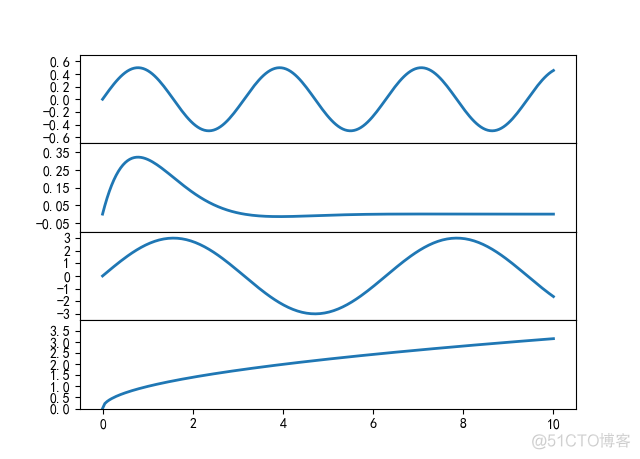


import numpy as np
x=np.linspace(0.0, 10.0, 200)
y=np.cos(x)*np.sin(x)
y2=np.exp(-x)*np.sin(x)
y3=3*np.sin(x)
y4=np.power(x, 0.5)
fig, (ax1, ax2, ax3, ax4)=plt.subplots(4, 1, sharex="all")
fig.subplots_adjust(hspace=0)
ax1.plot(x, y, ls="-", lw=2)
ax1.set_yticks(np.arange(-0.6, 0.7, 0.2))
ax1.set_ylim(-0.7, 0.7)
ax2.plot(x, y2, ls="-", lw=2)
ax2.set_yticks(np.arange(-0.05, 0.36, 0.1))
ax2.set_ylim(-0.1, 0.4)
ax3.plot(x, y3, ls="-", lw=2)
ax3.set_yticks(np.arange(-3, 4, 1))
ax3.set_ylim(-3.5, 3.5)
ax4.plot(x, y4, ls="-", lw=2)
ax4.set_yticks(np.arange(0.0, 3.6, 0.5))
ax4.set_ylim(0.0, 4.0)
plt.show()
View Code
=====================================================
图 7.8
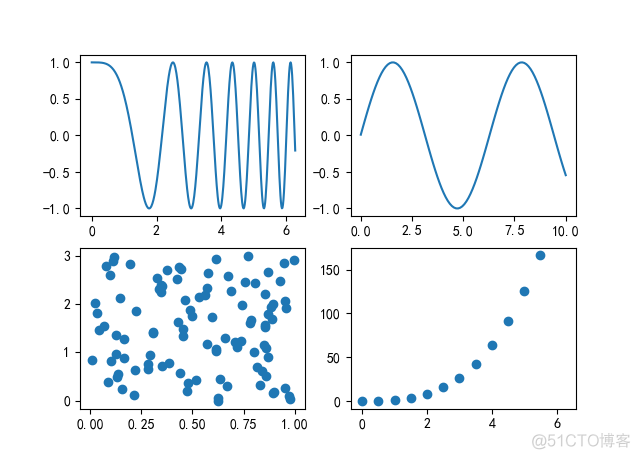


import numpy as np
x1=np.linspace(0, 2*np.pi, 400)
y1=np.cos(x1**2)
x2=np.linspace(0.01, 10, 100)
y2=np.sin(x2)
x3=np.random.rand(100)
y3=np.linspace(0, 3, 100)
x4=np.arange(0, 6, 0.5)
y4=np.power(x4, 3)
fig, ax=plt.subplots(2, 2)
ax1=plt.subplot(221)
ax1.plot(x1, y1)
ax2=plt.subplot(222)
ax2.plot(x2, y2)
ax3=plt.subplot(223)
ax3.scatter(x3, y3)
ax4=plt.subplot(224, sharex=ax1)
ax4.scatter(x4, y4)
plt.show()
View Code
=====================================================
图 7.9
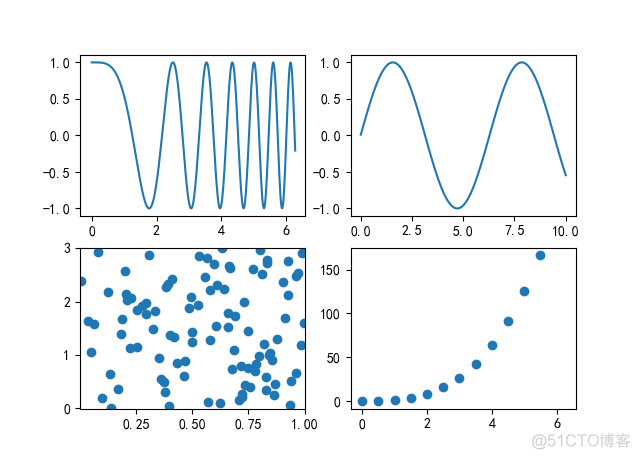


import numpy as np
x1=np.linspace(0, 2*np.pi, 400)
y1=np.cos(x1**2)
x2=np.linspace(0.01, 10, 100)
y2=np.sin(x2)
x3=np.random.rand(100)
y3=np.linspace(0, 3, 100)
x4=np.arange(0, 6, 0.5)
y4=np.power(x4, 3)
fig, ax=plt.subplots(2, 2)
ax1=plt.subplot(221)
ax1.plot(x1, y1)
ax2=plt.subplot(222)
ax2.plot(x2, y2)
ax3=plt.subplot(223)
plt.autoscale(enable=True, axis="both", tight=True)
ax3.scatter(x3, y3)
ax4=plt.subplot(224, sharex=ax1)
ax4.scatter(x4, y4)
plt.show()
View Code
=====================================================
【文章转自阿里云服务器代理商 http://www.558idc.com/aliyun.html 复制请保留原URL】
